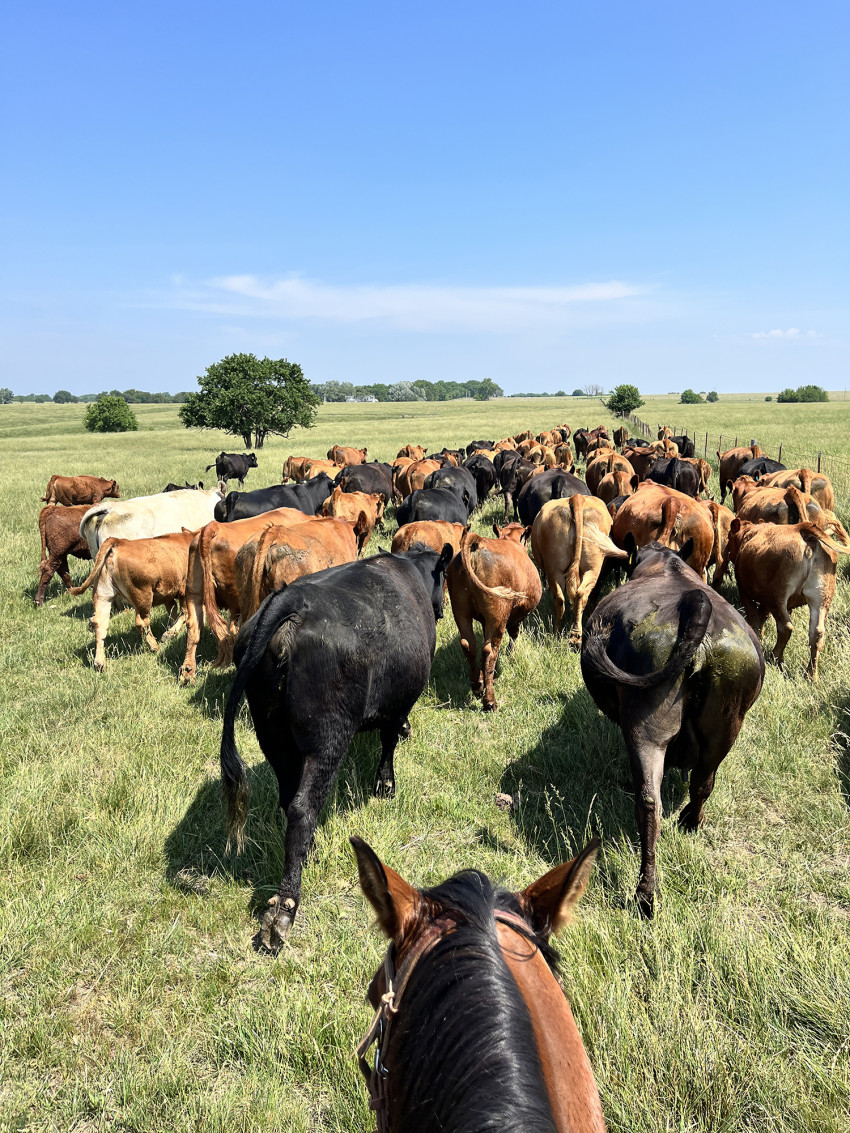By Brandi Buzzard on June 20, 2023
Rotational grazing rejuvenates grass on Kansas cattle ranches
The Cupid Shuffle for Cows

As a rancher, there aren’t many things that make my heart happier than watching our cows or stocker cattle walk into a pasture with knee-high grass, put their heads down and start munching. It’s a sight that would warm any cattle raiser’s heart, so it might surprise people to know we move those cattle to a new pasture when there is still a substantial amount of that gorgeous green grass to be grazed.
 There is a method to our madness: we follow a rotational grazing plan, meaning we rotate our cows through a set of pastures every few weeks to allow each pasture to rest and rejuvenate. For example, our largest amount of leased land is divided into four pastures, (and they have some odd names, so bear with me) so a grazing rotation for us might look like this:
There is a method to our madness: we follow a rotational grazing plan, meaning we rotate our cows through a set of pastures every few weeks to allow each pasture to rest and rejuvenate. For example, our largest amount of leased land is divided into four pastures, (and they have some odd names, so bear with me) so a grazing rotation for us might look like this:
Pasture I: Cows grazing for 2-3 weeks
Pasture J: Stockers grazing for 2-3 weeks
AM pasture: Herd bulls graze for 2-3 weeks
Cemetery pasture (it’s not an actual cemetery, it’s just across the road from one): Empty
After 2-3 weeks have passed, we will rotate the groups like so:
Pasture I: Empty
Pasture J: Herd bulls
AM pasture: Stockers grazing for 2-3 weeks
Cemetery pasture: Cows grazing here for 2-3 weeks
We don’t mind putting the herd bulls on pasture J after the stockers, because three bulls don’t eat anywhere near as much grass as our stockers do so the pasture can still strengthen its root system, grow and revive even though there are a few head of cattle in that pasture.
Then, after another few weeks has passed, we will move groups again based on the regrowth, which is heavily dependent on rainfall. While we are technically in a drought – as is most of cattle country – we have been fortunate to receive some good soaking rains the past few weeks, so the grass is holding up well.
 Why do we put so much time into shuffling cattle around and keeping an eye on the grass? Well, it’s partially because we are #GrassGeeks, but also because we know that if we are leaving a significant amount of grass left to be grazed, it can develop a strong root system. A strong root system improves the water-holding capacity of the soil, which in turn helps the overall nutrient quality of the soil. Our goal is to leave 50 percent of the grass behind every rotation, so if the grass was eight inches tall when cattle were turned out, we want to move them when it’s four inches tall. And before you ask, no we aren’t walking around our pastures with a ruler making sure we haven’t taken too much from each place, but hopefully that estimate provides insight into the mechanics of our grazing plan.
Why do we put so much time into shuffling cattle around and keeping an eye on the grass? Well, it’s partially because we are #GrassGeeks, but also because we know that if we are leaving a significant amount of grass left to be grazed, it can develop a strong root system. A strong root system improves the water-holding capacity of the soil, which in turn helps the overall nutrient quality of the soil. Our goal is to leave 50 percent of the grass behind every rotation, so if the grass was eight inches tall when cattle were turned out, we want to move them when it’s four inches tall. And before you ask, no we aren’t walking around our pastures with a ruler making sure we haven’t taken too much from each place, but hopefully that estimate provides insight into the mechanics of our grazing plan.
Before we adopted rotational grazing approximately four years ago, we operated on a continual grazing plan, which means the cows were on the same pasture for about 180 days straight – no rotating or movement. So, they would just eat wherever they could find grass and the pasture never had time to rest, regrow and strengthen the roots. The quality of our pastures wasn’t as high during this chapter, so we started talking to grazing experts and learning about rotational systems. We can always improve and strive to learn new methods that work for our ranch and the adoption of this grazing system is one that has made a huge positive impact.
 What we do on our ranch may not work for everyone, but it sure works for us, so we will continue to ask questions, learn and try our best to improve our ranching skills so we can make good choices for the resources and animals in our care.
What we do on our ranch may not work for everyone, but it sure works for us, so we will continue to ask questions, learn and try our best to improve our ranching skills so we can make good choices for the resources and animals in our care.




